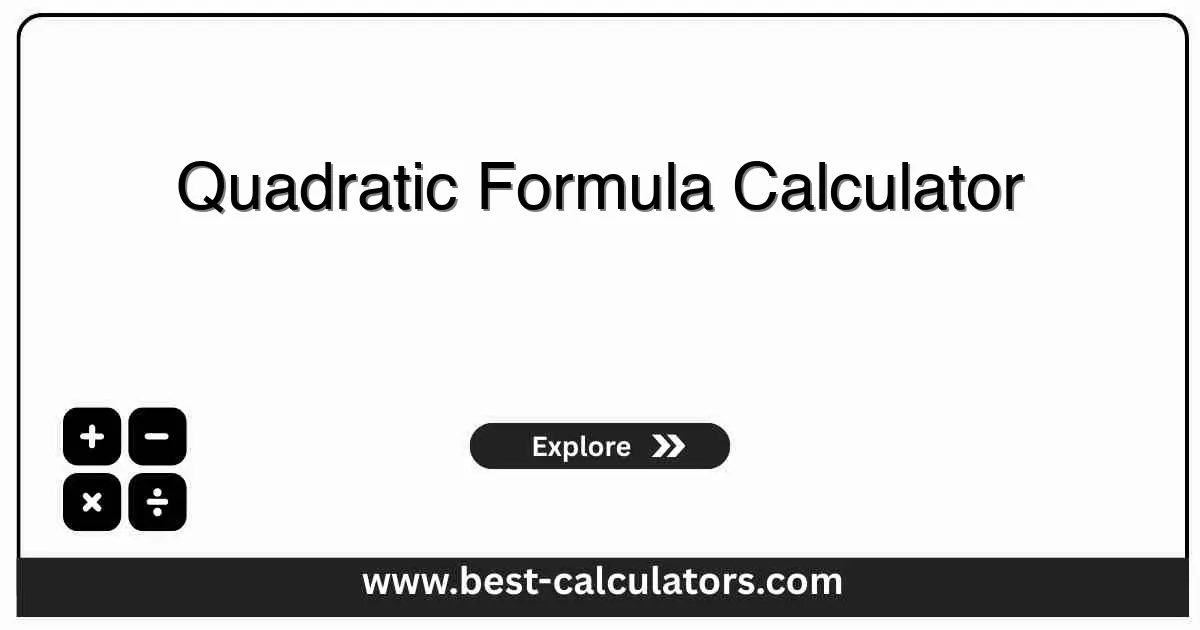Quadratic Formula Calculator - Solve ax²+bx+c=0
Free calculator to solve quadratic equations using the quadratic formula. Get both solutions, discriminant, and vertex instantly
Quadratic Formula Calculator
Solutions
Common Examples
What is a Quadratic Formula Calculator?
A quadratic formula calculator is a mathematical tool that solves quadratic equations of the form ax² + bx + c = 0 using the quadratic formula x = (-b ± √(b² - 4ac)) / (2a). This calculator instantly computes both solutions, the discriminant, and the vertex coordinates of the parabola.
Quadratic equations appear throughout mathematics, physics, engineering, and economics. They describe projectile motion, optimize business profits, calculate area and perimeter problems, and model natural phenomena. Understanding how to solve quadratic equations is fundamental to algebra and calculus.
This calculator handles all types of quadratic equations including those with two real solutions, one repeated solution, or two complex solutions. It automatically determines the nature of solutions based on the discriminant value and provides complete information about the parabola including its vertex.
For related mathematical calculations, try our system of equations calculator for solving multiple equations simultaneously, or the fraction calculator for working with fractions. The percentage calculator helps with percentage calculations in various contexts.
How the Quadratic Formula Calculator Works
The calculator applies the quadratic formula: x = (-b ± √(b² - 4ac)) / (2a). First, it calculates the discriminant Δ = b² - 4ac, which determines the nature of solutions. The ± symbol indicates two solutions: x₁ uses addition and x₂ uses subtraction.
For the vertex calculation, the calculator finds the x-coordinate using x = -b/(2a), then substitutes this value into the original equation to find the y-coordinate. The vertex represents the turning point of the parabola, either the maximum (if a < 0) or minimum (if a > 0) point.
When the discriminant is positive, two distinct real solutions exist. Zero discriminant produces one repeated real solution. Negative discriminant yields two complex conjugate solutions of the form p ± qi, where i is the imaginary unit.
Key Concepts Explained
Quadratic Equation
A polynomial equation of degree 2 in standard form ax² + bx + c = 0, where a ≠ 0. The graph is a parabola that opens upward (a > 0) or downward (a < 0).
Discriminant
The value b² - 4ac that determines solution types. Positive gives two real roots, zero gives one repeated root, negative gives complex roots.
Vertex
The turning point of the parabola at coordinates (-b/(2a), f(-b/(2a))). Represents the maximum or minimum value of the quadratic function.
Complex Solutions
When discriminant is negative, solutions are complex numbers a + bi where i = √(-1). They appear as conjugate pairs p + qi and p - qi.
How to Use This Calculator
Enter Coefficient a
Input the coefficient of x² (must be non-zero). This determines if parabola opens upward or downward
Enter Coefficient b
Input the coefficient of x. This value affects the position of the vertex and axis of symmetry
Enter Coefficient c
Input the constant term. This represents the y-intercept where the parabola crosses the y-axis
View Solutions
Click Solve to see both solutions, discriminant value, solution type, and vertex coordinates instantly
Benefits of Using This Calculator
Using this quadratic formula calculator saves time and eliminates arithmetic errors in complex calculations involving square roots and negative numbers. The calculator provides comprehensive information beyond just the solutions.
Instant Results: Get both solutions immediately instead of working through multi-step manual calculations
Complete Information: See discriminant, solution type, and vertex in one calculation
Handle Complex Numbers: Automatically computes complex solutions when discriminant is negative
Verify Homework: Check your manual solutions to ensure accuracy before submission
Learn Patterns: Understand how coefficients affect solutions and parabola shape
Factors That Affect Your Results
The coefficients you enter directly determine the nature and values of solutions. Understanding these relationships helps predict solution types before calculation.
Coefficient a Impact
The sign of a determines parabola direction: positive opens upward with minimum vertex, negative opens downward with maximum vertex. Larger absolute values create narrower parabolas.
Discriminant Value
The discriminant b² - 4ac completely determines solution nature. Positive gives two x-intercepts, zero gives one x-intercept at vertex, negative gives no x-intercepts.
Coefficient Relationships
When b² = 4ac exactly, the parabola touches the x-axis at one point. When b = 0, the parabola is symmetric about the y-axis with vertex on the y-axis.

Frequently Asked Questions (FAQ)
Q: What is the quadratic formula?
A: The quadratic formula is x = (-b ± √(b² - 4ac)) / (2a), used to solve quadratic equations of the form ax² + bx + c = 0. It provides both solutions for any quadratic equation, including real and complex solutions.
Q: What is the discriminant in quadratic equations?
A: The discriminant is the expression b² - 4ac under the square root in the quadratic formula. It determines the nature of solutions: positive discriminant gives two real solutions, zero gives one repeated solution, and negative gives two complex solutions.
Q: How do you find the vertex of a parabola?
A: The vertex of a parabola y = ax² + bx + c is located at x = -b/(2a). Substitute this x-value into the original equation to find the y-coordinate. The vertex represents the maximum or minimum point of the parabola.
Q: Can quadratic equations have no real solutions?
A: Yes, when the discriminant (b² - 4ac) is negative, the quadratic equation has no real solutions but has two complex conjugate solutions. This means the parabola does not intersect the x-axis.
Q: What is a repeated root in quadratic equations?
A: A repeated root occurs when the discriminant equals zero, giving one solution that appears twice. Graphically, this means the parabola touches the x-axis at exactly one point, which is the vertex of the parabola.